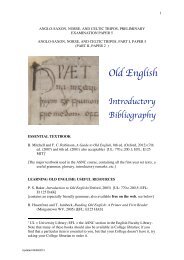Scandinavian history in the Viking age - Department of Anglo-Saxon ...
Scandinavian history in the Viking age - Department of Anglo-Saxon ...
Scandinavian history in the Viking age - Department of Anglo-Saxon ...
Create successful ePaper yourself
Turn your PDF publications into a flip-book with our unique Google optimized e-Paper software.
<strong>Scand<strong>in</strong>avian</strong> History <strong>in</strong> <strong>the</strong> Vik<strong>in</strong>g Age<br />
[K25] M. Clunies Ross, Prolonged echoes: Old Norse myths <strong>in</strong> medieval nor<strong>the</strong>rn society, 2 vols, The<br />
Vik<strong>in</strong>g collection 7, 10 (1994-98) [UL 463:1.c.95.115-16]<br />
[K26] H.R. Ellis Davidson, Vik<strong>in</strong>g and Norse mythology (1996) [UL 465:26.b.95.4]<br />
[K27] C. Larr<strong>in</strong>gton, ‘Scand<strong>in</strong>avia’, The woman’s guide to mythology (1997), 137-61 [UL 1998.9.3417]<br />
[K28] J. H<strong>in</strong>es, ‘Myth and reality: <strong>the</strong> contribution <strong>of</strong> archaeology’, (A61h):165-74<br />
[K29] M. Clunies Ross, ‘The conservation and re<strong>in</strong>terpretation <strong>of</strong> myth <strong>in</strong> medieval Icelandic writ<strong>in</strong>gs’,<br />
(B235):116-139<br />
The pan<strong>the</strong>on<br />
As conventionally def<strong>in</strong>ed, <strong>the</strong> Norse pan<strong>the</strong>on was divided <strong>in</strong>to two groups; <strong>the</strong> Æsir, whose functions<br />
seem to have been heavily martial, and <strong>the</strong> Vanir, who were by contrast worshipped for fertility. The<br />
validity <strong>of</strong> such a dist<strong>in</strong>ction for Vik<strong>in</strong>g-<strong>age</strong> Scand<strong>in</strong>avia is naturally slender, but has been seen as a<br />
mythic exploration <strong>of</strong> <strong>the</strong> tensions between ‘old’ and ‘new’ div<strong>in</strong>ities; it is notable that <strong>in</strong> verse <strong>the</strong> Æsir<br />
seem to predom<strong>in</strong>ate <strong>in</strong> status, whereas place-names (K90 ff.) pa<strong>in</strong>t a much more ambiguous picture.<br />
[K30] Ó. Briem, Vanir og Æsir, SI 21 (1963) [UL 599:01.c.1.5] (E.s.)<br />
[K31] H.R. Ellis Davidson, Gods and myths <strong>of</strong> nor<strong>the</strong>rn Europe (1964) [UL 9460.d.1156]<br />
[K32] G. Dumézil, Gods <strong>of</strong> <strong>the</strong> ancient Northmen, transl. E. Haugen, Publications <strong>of</strong> <strong>the</strong> UCLA Center<br />
for <strong>the</strong> Study <strong>of</strong> Comparative Folklore and Mythology 3 (1973) [UL 465:26.c.95.7]; a classic if<br />
contentious study, cf. R.I. P<strong>age</strong>, ‘Dumézil revisited’, SBVS 20 (1978-81), 49-69<br />
[K33] U. Dronke, ‘The war <strong>of</strong> <strong>the</strong> Æsir and Vanir <strong>in</strong> V²luspá’, (O52):223-38<br />
[K34] L. Motz, The k<strong>in</strong>g, <strong>the</strong> champion and <strong>the</strong> sorcerer: a study <strong>in</strong> Germanic myth, Studia medievalia<br />
septentrionalia 1 (1996) [UL 9002.d.3366]; with chapters on Od<strong>in</strong>, Thor and Frey<br />
Od<strong>in</strong><br />
As <strong>the</strong> lead<strong>in</strong>g figure <strong>in</strong> <strong>the</strong> Norse pan<strong>the</strong>on, at least accord<strong>in</strong>g to most literary sources, <strong>the</strong> role <strong>of</strong> Od<strong>in</strong><br />
has come under particular scrut<strong>in</strong>y. Various factors suggest that Od<strong>in</strong>’s role <strong>in</strong> mythological material has<br />
been exaggerated: his identification with <strong>the</strong> Roman Mercury pales when compared to that <strong>of</strong> Thor with<br />
Jove, while reports <strong>of</strong> cult-sites such as that <strong>of</strong> Uppsala (K115 ff.) by Adam <strong>of</strong> Bremen aga<strong>in</strong> place Thor<br />
<strong>in</strong> prime position. For Od<strong>in</strong>’s role <strong>in</strong> <strong>the</strong> Valhalla myth see (K55 ff.); for a personal view by a devotee<br />
(B523b).<br />
[K36] E.O.G. Turville-Petre, ‘The cult <strong>of</strong> Od<strong>in</strong> <strong>in</strong> Iceland’, (O4):1-19<br />
[K37] K. Hald, ‘The cult <strong>of</strong> Od<strong>in</strong> <strong>in</strong> Danish place-names’, (O20):99-109<br />
[K38] S. Grundy, Miscellaneous studies towards <strong>the</strong> cult <strong>of</strong> Od<strong>in</strong>n (1994) [ASNC]<br />
Thor<br />
[K39] R. Perk<strong>in</strong>s, Thor <strong>the</strong> W<strong>in</strong>d-Raiser and <strong>the</strong> Eyrarland Im<strong>age</strong> (2001)<br />
O<strong>the</strong>r mythological figures<br />
It is possible, if bold, to suggest that <strong>the</strong> pan<strong>the</strong>on represented <strong>the</strong> more ‘public’ face <strong>of</strong> Norse pagan<br />
belief, but a wide scatter<strong>in</strong>g <strong>of</strong> (<strong>of</strong>ten frustrat<strong>in</strong>gly vague) sources confirm <strong>the</strong> worship <strong>of</strong> o<strong>the</strong>r<br />
mythological figures, perhaps <strong>the</strong> recipients <strong>of</strong> more localised or private cults.<br />
[K40] F. Ström, Diser, nornor, valkyrjor: fruktbarhetskult och sakralt kungadöme i Norden, KVHAA<br />
handl<strong>in</strong>gar, filologisk-filos<strong>of</strong>iska serien 1 (1954) [UL 500:05.c.64.1]<br />
The giants<br />
The role <strong>of</strong> giants <strong>in</strong> Norse mythology is ambiguous; <strong>the</strong>y are at once presented as <strong>the</strong> ancestors,<br />
adversaries, and prospective brides or husbands <strong>of</strong> <strong>the</strong> gods.<br />
[K43] G. Ste<strong>in</strong>sland, ‘Giants as recipients <strong>of</strong> cult <strong>in</strong> <strong>the</strong> Vik<strong>in</strong>g <strong>age</strong>?’, (K8):212-22<br />
[K44] L. Motz, ‘The families <strong>of</strong> giants’, ANF 102 (1987), 216-36<br />
Elves, dwarves, and dísir<br />
[K45] The orig<strong>in</strong>s and roles <strong>of</strong> <strong>the</strong> figures known as elves, dwarves, and dísir <strong>in</strong> pagan mythology are<br />
hotly disputed, but <strong>the</strong>y may have been recipients <strong>of</strong> more local cults; <strong>in</strong> Sigvat’s Austrfararvísur<br />
106






